Content
- 1 Soil preparation
- 2 Seed treatment
- 3 Sowing seeds
- 4 Further care of seedlings
- 5 When and how to plant basil seedlings
- 6 Drainage
- 7 Growing conditions for seedlings
- 8 Possible Basil Seedling Problems
- 9 Landing in the ground
- 10 Growing basil seedlings from seeds at home When to plant
- 11 How to sow basil at home video:
- 12 What to do if the basil seedlings have outgrown the video:
- 13 Preparing a site for planting a basil
- 14 Planting basil seedlings outdoors
- 15 Growing basil seeds outdoors
- 16 How to care for basil outdoors
- 17 How to cut basil
- 18 Types and varieties of basil with photos and names
- 19 Growing basil through seedlings
I have long dreamed of growing basil from homemade seeds, but somehow I could not collect them. And so a neighbor shared her last year's seeds. Tell me, are there any peculiarities of growing basil seedlings at home?
Basil is one of the aromatic representatives of spicy plants loved by gardeners. Since it is an annual crop, it should be planted annually. Due to the fact that basil practically does not tolerate low temperatures, it is mainly grown in seedlings. This method allows you not only to get early greens, but also to collect your own seeds for the next season.
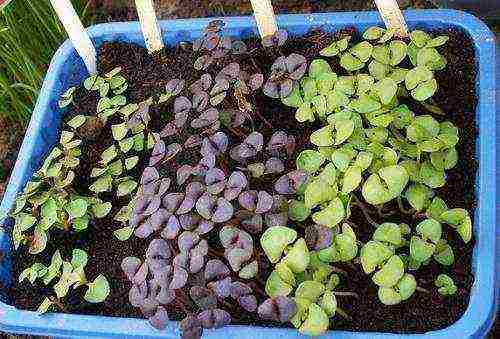
At home, growing basil seedlings is similar to other garden crops, taking into account the individual characteristics of this spicy plant. The main activities carried out in order to obtain strong, healthy seedlings include:
- selection and preparation of nutrient substrate;
- pre-sowing seed treatment;
- correct sowing;
- proper care of the seedlings.
Soil preparation
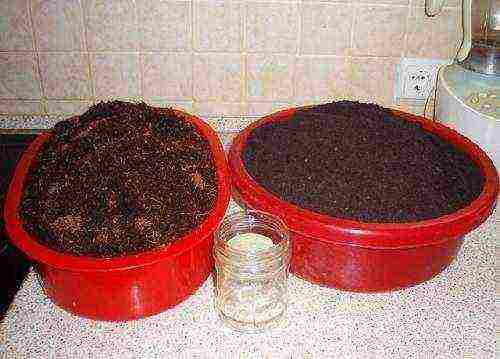
Basil loves loose and nutritious soil, which you can prepare yourself by mixing:
- 4 parts of peat;
- 2 parts of humus;
- 1 part sand (washed).
Mix all components well and steam without fail in order to disinfect. The nutrient substrate can be obtained from your specialist supply store. In this case, it will be enough to spill it with a solution of potassium permanganate or treat it with Fitosporin.
Seed treatment
In order for the seeds to sprout faster and more amicably, experienced gardeners recommend soaking them in a solution based on a growth stimulant prepared according to the instructions. For these purposes, Zircon or Albit are suitable. Leave the processed seeds to dry out a little.
Sowing seeds
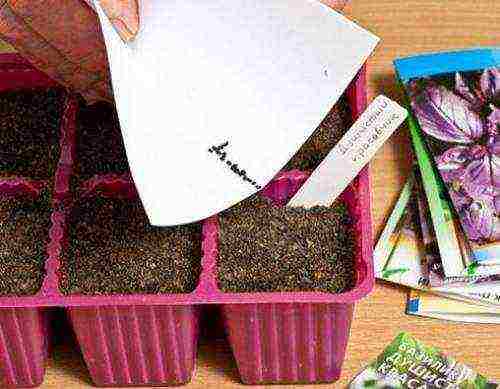
Seeds for seedlings can be sown at the end of March. In a container of medium depth (about 7 cm), pour a layer of prepared soil, slightly compacting it. Basil does not react well to stagnant water, therefore, a drainage layer (pieces of foam, expanded clay) must be laid on the bottom of the planting boxes before laying the soil.
Place the seeds on the soil surface in rows and cover them on top with a layer of earth about 1 cm thick. Spray the plantings liberally with a spray bottle, cover the box with foil and place on the southern windowsill.
So that the seedlings do not fight for a place in the sun, it is better to immediately spread the seeds, observing the distance between them at 5 cm, and in the row spacing - 10 cm.
If you do not plan to collect seeds, basil can be sown directly in open ground in early June. Fresh greens will ripen in July.
Further care of seedlings
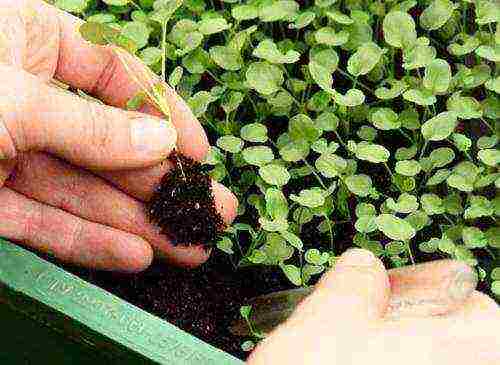
In the room where the container with seeds is located, it is necessary to maintain a temperature of at least 20 degrees Celsius. After the emergence of seedlings, remove the film and reduce the temperature to 17 degrees so that the seedlings do not stretch out. Watering should be done with warm water as the topsoil dries out. If necessary, you can install additional lighting.
At the phase of the appearance of 2 true leaves, dive the seedlings into separate cups, mixing ash and mineral fertilizers into the soil during transplantation. As soon as 5 leaves are formed on the seedlings, pinch the top to stimulate the formation of side shoots.
10-14 days before transplanting seedlings into open ground or a greenhouse, you need to start hardening the plants. You can transplant basil into the beds at the end of May.
Basil: sowing seeds for seedlings, picking - video
Basil is a spicy culture loved by many. It is added to meat dishes, soups, salads, desserts, when salting vegetables. Due to the compactness of the bush, various shades of leaves, it is used to decorate the site. Decorated with pink, white, white and purple flowers, basil looks great among garden plantings. Fragrant greenery growing close to berry bushes repels insect pests. To get early greens, they are grown through seedlings. Knowing how to plant it correctly can achieve excellent results.
When and how to plant basil seedlings
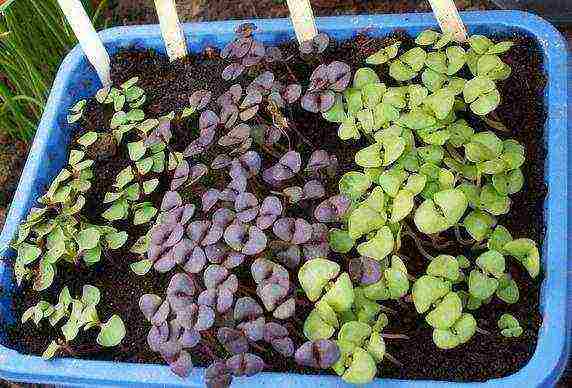
To get early greens, they are grown through seedlings.
Sowing dates
Basil is sown at the end of March. In 35-50 days after the emergence of seedlings, the seedlings are planted on the site.
The choice of soil for planting
The soil is used light, loose, without lumps. You can buy ready-made potting mix. It is spilled with a manganese solution or Fitosporin. If you prepare the earthen mixture yourself, you should steam it for 1 hour. The soil should be composed of peat, compost and sand (4: 2: 1).
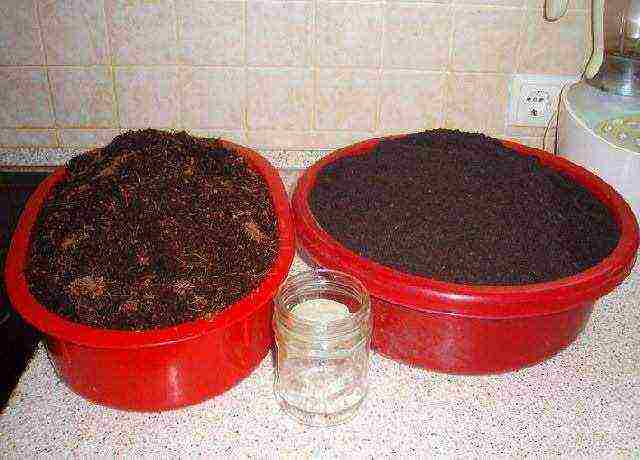
Basil seedling soil can be prepared by yourself
Drainage
Basil does not like waterlogging. To avoid stagnation of water, expanded clay, crushed polystyrene with a layer of 3 cm, is laid on the bottom of the container.

Drainage is laid at the bottom of the container
Selection of containers
For growing seedlings, use shallow containers (up to 7 cm) with a pallet. However, it is preferable to immediately plant seeds in separate cells, since when grown in a common container with subsequent picking, the seedlings will take an extra week to adapt to new conditions.
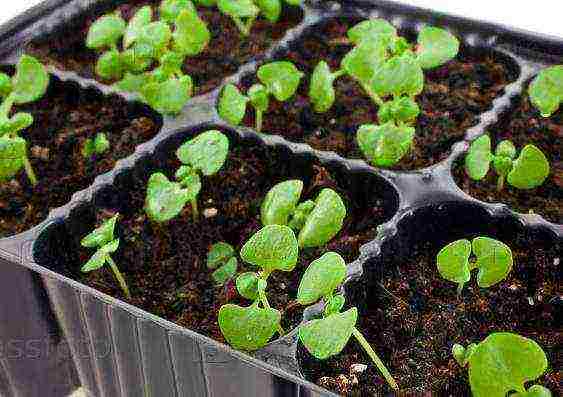
For growing seedlings, shallow containers with cells are suitable
Advice! Better to use peat pots. When transplanted into the ground, the plant is planted together with the container, without damaging the young roots.
Seed preparation
For better germination, the seeds are kept in a solution of a growth stimulator - Zircon. Then let them dry a little.
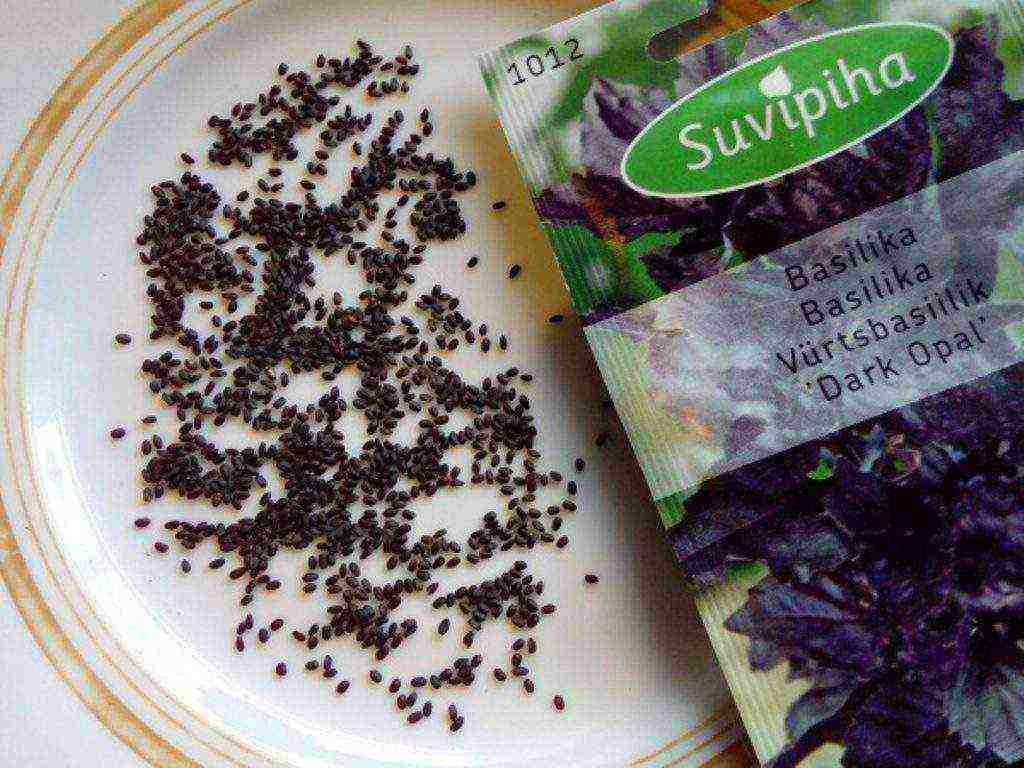
Basil is grown from seed
Seeds in the shell are wrapped in gauze and placed in water for an hour or in hydrogen peroxide solution for 15 minutes.
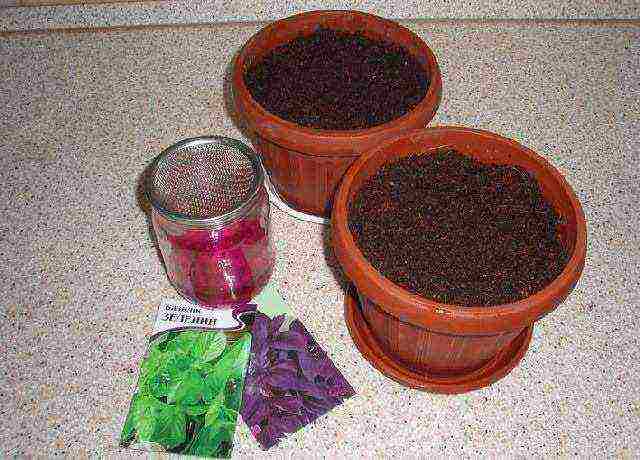
Before sowing, the seeds are disinfected
How to plant at home: a step-by-step process
- Prepared soil is poured into a container with a drainage layer.
- Moisten it and make grooves 0.5 cm deep with a distance of 5 cm between them.
- Seeds are spread every 2 cm, covered with earth and lightly tamped.
- Cover with a film and put in a warm place with a temperature of + 25-28.
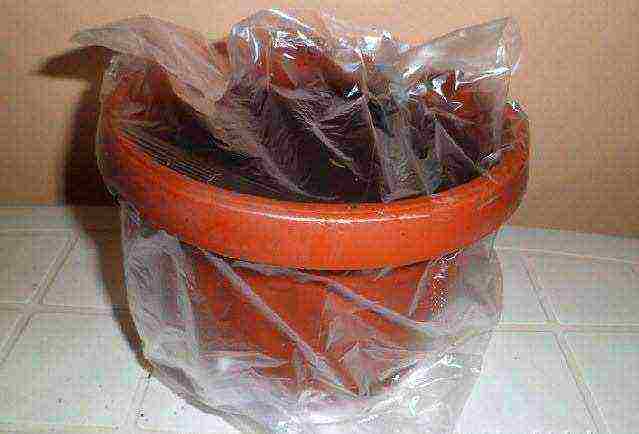
Seed pots are placed in a greenhouse
Moisture, warmth and air access are the main conditions for seed germination. The greenhouse is regularly ventilated, condensate is removed, and watering is carried out.
The sprouts will appear in 7-14 days. The shelter is removed - the high temperature is no longer needed. To prevent stretching of seedlings, keep the temperature + 16 ... + 20 ° С.
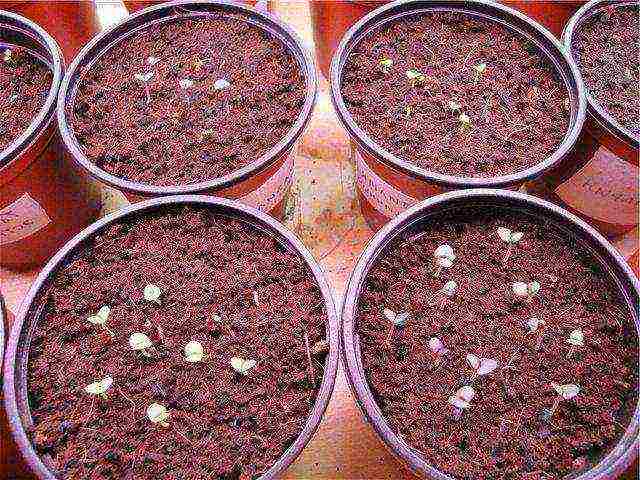
To prevent the seedlings from stretching, maintain a temperature of + 16-20 degrees
How is sowing carried out: video tips
Growing conditions for seedlings
It is not difficult to grow strong seedlings, providing them with favorable conditions: choose suitable soil and good seed material, observe light and temperature conditions, water and fertilize regularly.
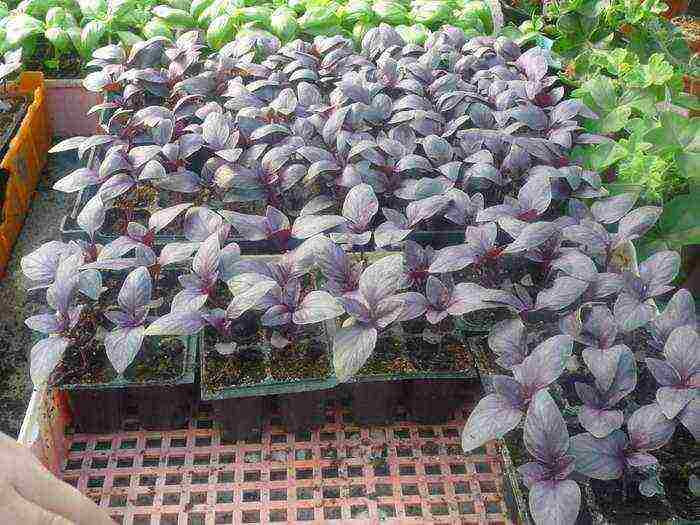
You can grow healthy seedlings by creating comfortable conditions for them.
Lighting
Small seedlings are in great need of light. Basil grows poorly in places that are poorly lit by the sun. Seedlings are placed on the southern windowsill and additional lighting is turned on, especially in the first five days. It is best to use Reflax lamps, which are installed above the plants. They have a built-in mirrored reflector that allows all the light to be directed onto the plant. It is necessary to carry out supplementary lighting of seedlings up to their planting in the ground.
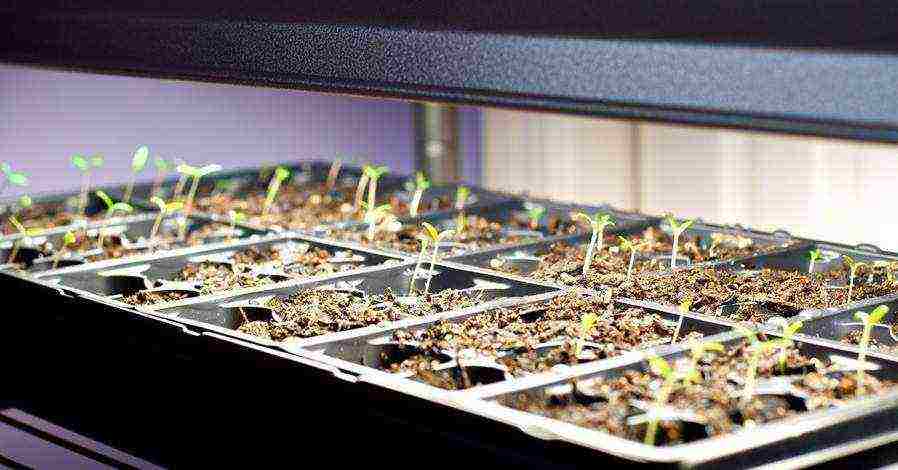
For additional lighting, the lamps are installed on top
Watering
This culture is demanding on moisture, especially during seed germination. But basil is watered very carefully, every 3-4 days. And only with warm water. Make sure that the water in the pan does not stagnate. Waterlogging of the soil leads to damping of the roots, increases the risk of black leg disease. After watering, be sure to loosen the ground.
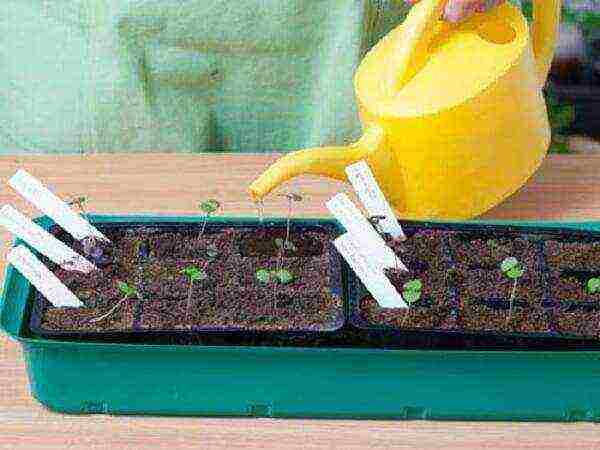
Basil is poured very carefully
Top dressing
Basil is very responsive to fertilization: the introduction of nitrogen contributes to the growth of green mass, phosphorus and potassium - it increases the content of essential oil in the leaves.
7 days after the emergence of seedlings, fertilizing is carried out with a solution of ash (10 g1 l).
A week after the pick, a solution of complex fertilizer is applied. After feeding, the seedlings are watered with clean water from a watering can to prevent burns.
In the future, the plants are fed after each cut.
Dive
At the age of 20-25 days, when the first two true leaves grow, the seedlings dive into pots. The seedlings are not deeply buried, they are watered. Plants will take time to get used to the new environment.
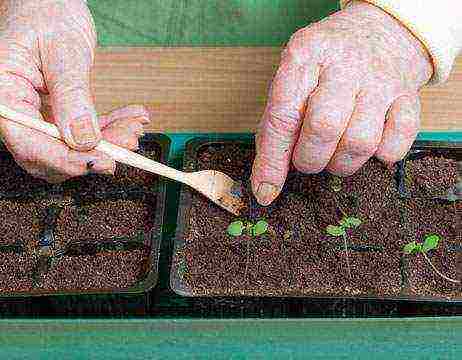
When diving, the seedlings do not deeply deepen
When sowing seeds into individual cells, the plants are thinned out as they grow.
After the appearance of 5-6 pairs of leaves, the crown of the seedling can be pinched, which will allow the plant to bush and not form peduncles for a long time.
Cutting of greenery can be carried out one month after sowing, by which time the plants will have risen 10-12 cm in height.
Basil. Seedlings in a snail - video
Potential Basil Seedling Problems
Seedlings are practically not affected by pests, but in unfavorable conditions they can get sick, which will immediately affect its appearance.
Pulling
With a lack of light and heat, too dense planting, the seedlings wither and stretch. It is necessary to move the plants to a warmer and brighter place, use additional lighting. Densely planted plants should be thinned out.
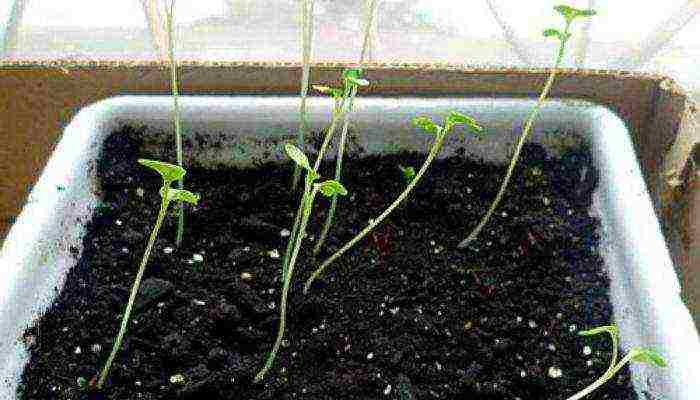
Basil seedlings stretch out under unfavorable conditions.
When pulling out the seedlings, a long stalk is placed in a small depression next to the plant, sprinkled with earth, watered. Soon, small roots will appear on the dug-in part.
Blackleg
With excessive moisture or watering with cold water, the seedlings can suffer from the black leg. The root collar becomes thin, turns black, the plant disappears.
The soil must be watered moderately with warm water and monitor the temperature regime.
To avoid such problems, the plants are not planted too thickly. Then they do not interfere with each other's development, they receive the necessary nutrition and light. To prevent black leg, the soil is sprinkled with ash before watering, which not only disinfects the soil, but also feeds it due to the content of potassium and phosphorus.
Yellowing of leaves
Yellowing and drying of seedlings can be caused by micronutrient deficiencies. In the nutrient soil, the plant has bright green leaves. The situation can be corrected by introducing Fitosporin.
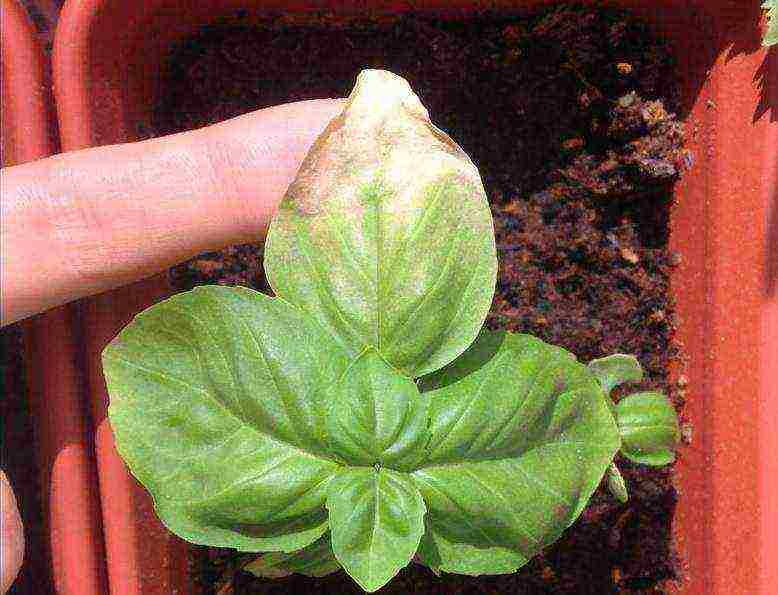
Yellowed leaves are a signal that the plant needs to be fed
Spots on the leaves
Spots may appear on the leaves - this is a sunburn received by the plant when it is under too bright spring sun. It is necessary to shade young seedlings on a hot afternoon with blinds or curtains.
Landing in the ground
Healthy basil seedlings are stocky, with 4–6 true leaves and the rich color typical of this species.
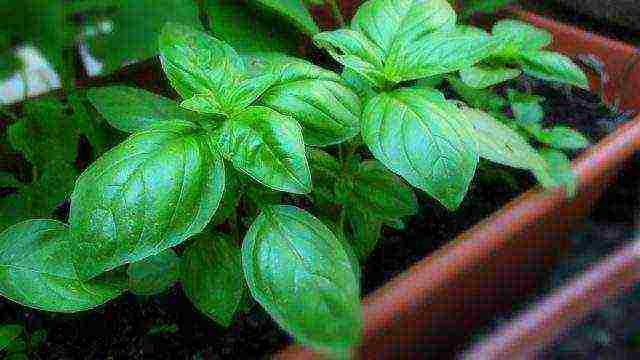
Strong basil seedlings are ready for planting
2 weeks before planting, they begin to harden it in the fresh air at a temperature not lower than + 5-10 ° С.
Seedlings are planted on the site in late May - early June, when the soil warms up to + 15 ° C. Choose a place protected from the wind, illuminated for most of the day. They are planted at a distance of 30 cm from each other - for high varieties, and 15 cm - for compact specimens.
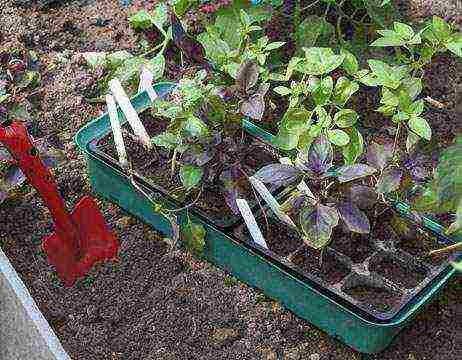
At the end of May, seedlings are planted in the ground.
After planting, watering is carried out. Basil will quickly build up its green mass.
This is a unique quote
On a note. The ancient Romans considered basil to be a symbol of success: for prosperity and longevity, you need to consume it as much as possible.
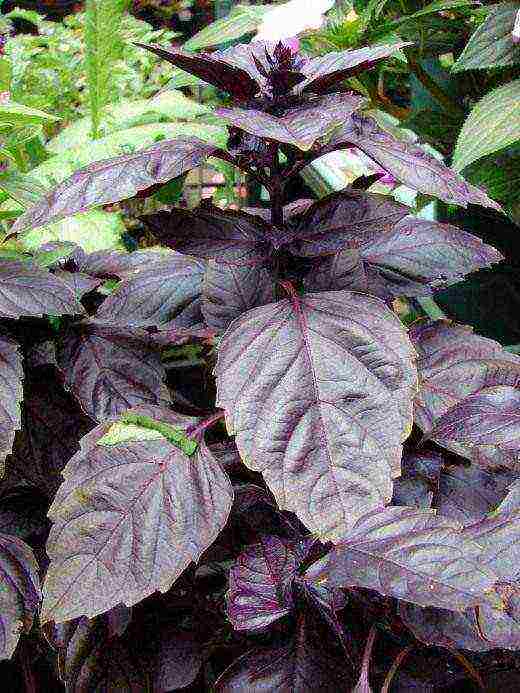
Basil, after planting in the ground, quickly grows
Growing basil seedlings requires attention, accuracy and patience. Only with the creation of the necessary conditions and the implementation of preventive measures to protect against diseases, it is possible to grow strong, viable healthy seedlings.
Basil is a spicy herb. Originally from Asia, where it grows in warm climates. In temperate latitudes, it is cultivated only through the cultivation of seedlings.
This fragrant greenery looks decorative. Herbaceous bush, 20-60 cm high, densely covered with oval-shaped leaves with pointed tops. They are arranged in tiers, the surface of the leaf plates is glossy, the color is green or dark purple. Basil begins to bloom in late June and early August. The flowers are small, whitish in color, gather in a spike-shaped inflorescence.
Growing basil seedlings from seeds at home When to plant

Basil shoots photo
Start sowing basil seedlings in late March - early April... Take a wide container, fill it with nutritious soil (peat, humus, garden soil in equal proportions).
- Cover the seeds to a depth of no more than 1 cm.
- You can sow often - then plant the strong specimens in separate containers, and get rid of the weak ones.
- Moisten the soil, cover the crops with glass or foil, maintain the air temperature within 26-27 ° C.
- Ventilate the greenhouse to remove condensation and keep the soil moist.
- Seedlings will appear in about 10 days.
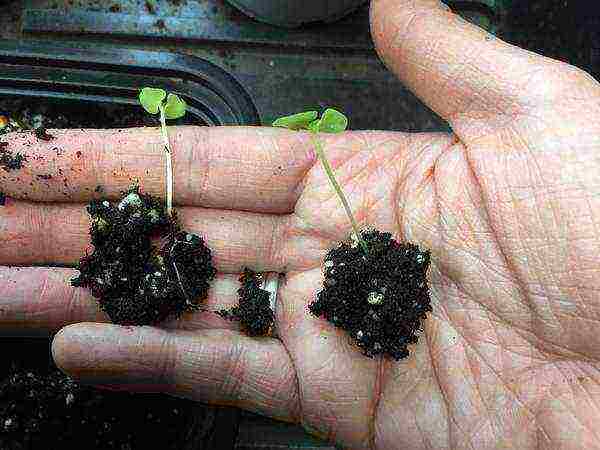
Grown up basil seedlings need to dive photo
- With the appearance of two or three leaves, plant in separate containers.
- The ideal option would be to grow seedlings in a greenhouse. If this is not possible, grow on an eastern or western windowsill.
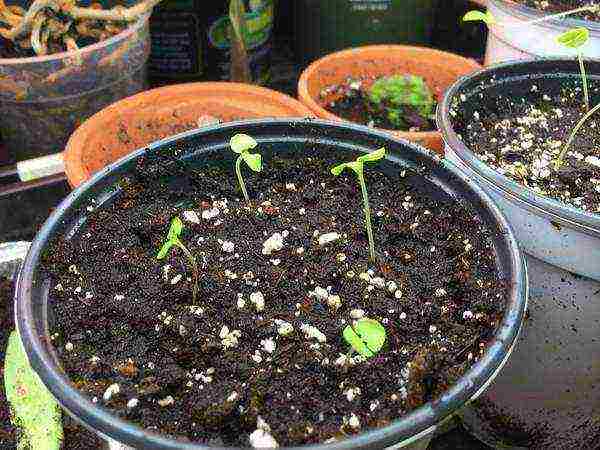
Pickled basil seedlings photo
- Maintain optimum soil moisture, avoiding dryness or waterlogging.
- Excessive moisture can affect the seedlings with a black leg. In this case, treat the plants with a solution of copper sulfate (for 2 liters of water, 1 tsp of powder).
- When the seedlings grow a little and release several pairs of real leaves, they should be pinched (cut off the tip of the shoot).
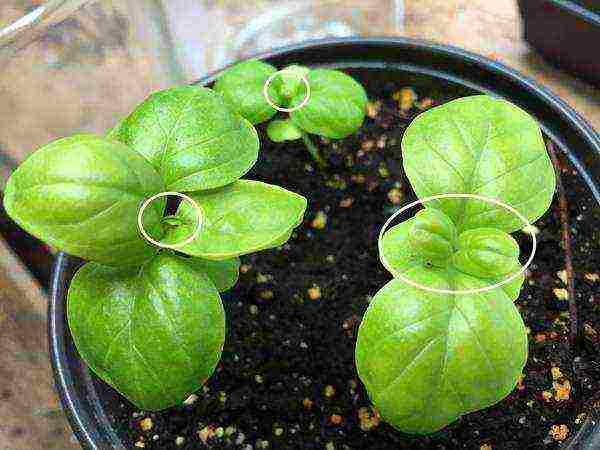
How to pinch basil seedlings photo
Cutting off the top pair of leaves along with the growth point, you will get approximately the same result as in the photo below:
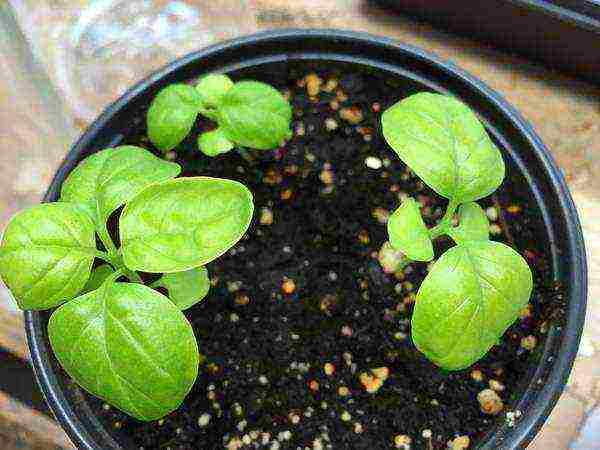
Basil seedlings after pinching photo
After a little time, at the cut point, the plants will start up additional shoots, due to which the bushes will be thicker and leafy:
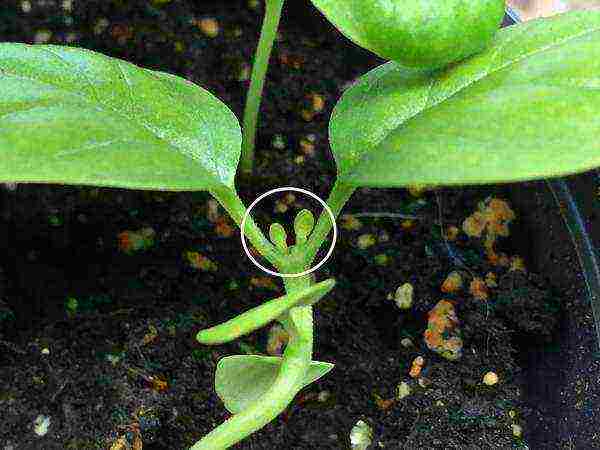
Basil seedlings gave lateral shoots after pinching photo
The seedlings should be fed every 2 weeks. Apply complex mineral fertilizers: phosphorus, potassium, nitrogen in a ratio of 5: 3: 2.
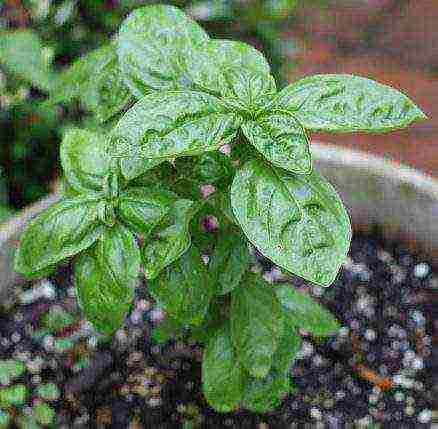
Basil seedlings ready for planting photo
Temper the seedlings little by little. 10-7 days before planting in open ground during the daytime, take out to fresh air.
Also, 7-5 days before transplanting, you should reduce watering.
How to sow basil at home video:
What to do if the basil seedlings have outgrown the video:
Preparing a site for planting a basil
Seat selection
A heat-loving plant requires appropriate conditions. Find an open, sunny area on the south or southeast side. Drafts and cold gusts of wind can damage the plant. Plant basil in a secluded place: along fences, buildings, between bushes.
The soil needs light, loose, fertile, permeable to water and air.
Predecessors
Desirable precursors: cucumbers, tomatoes, peas, beans, beans, lentils, lupins. Basil should not be cultivated in the same place for several years in a row, as this provokes fusarium disease (brown spots on the leaves). You can return the basil to its original place after 5 years.
Land preparation
Site preparation should be done in the fall. For digging, apply per 1 m²: from 3.5 to 5 kg of compost or humus, 22 g of superphosphate, 12 g of potassium salt.
Planting basil seedlings outdoors
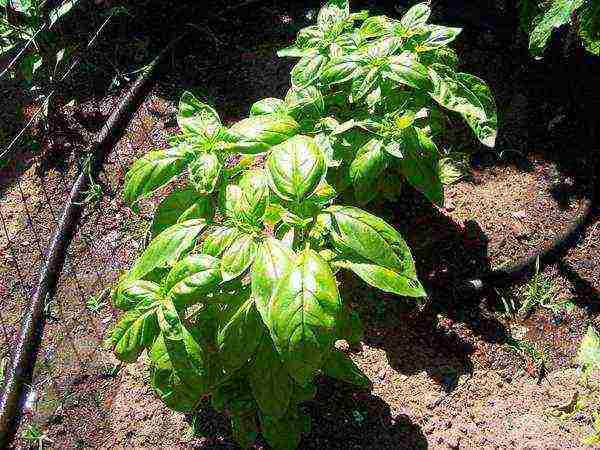
How to plant basil in the ground photo
You can transplant seedlings when the threat of recurrent frosts has completely passed (the last days of May-early June).
- Plant in rows, keeping a distance of 20-25 cm between bushes, row spacing - 30-35 cm.
- Make holes in accordance with the size of the root system of the plant, water well (about 1 liter of warm water in each hole).
- Remove the plants from the container along with the earthen clod, transfer into the hole, slightly deepening the stem to the first true leaves.
- Gently press the soil around the plant with your fingers.
- Water the plantings abundantly; at first, it is advisable to shade.
Further care is simple: timely abundant watering, weeding and loosening of the soil. It is helpful to mulch the row spacings to reduce watering and get rid of weeds.
Growing basil seeds outdoors
You need to sow basil at the end of March-April, if you want to have time to grow full-fledged bushes with fragrant herbs. To sow basil with seeds directly into the ground, you need to prepare a greenhouse: cover the arcs with foil or build a greenhouse from old window frames. The ground needs to be warm enough to sow basil.
Sow shallow, up to 1 cm deep. The distance between the furrows is 15-20 cm. Water so that the water does not stagnate and cover the greenhouse. Ventilate in sunny warm weather, do not allow the temperature inside the greenhouse to rise more than 24 ° C. On warm days, open it altogether. Seedlings are thinned 2-3 times, leaving 8-10 cm between the plants. Pinch the central shoot over the 2-3rd pair of leaves. Transplant the grown seedlings to a permanent place in the absence of the threat of night frosts according to the 25x30 cm scheme.
How to care for basil outdoors
Shelter from the cold
The most important thing in grooming is to provide warmth. At the slightest threat of a severe cold snap at night, cover with a film. This applies more to extensive plantings, when the goal is to preserve the presentation of the greenery. To grow a few bushes for personal use, such hassle is not necessary.
Watering and loosening
Provide abundant watering, but do not allow moisture to stagnate. Water for irrigation should be warm, settled, bring it through a watering can, preferably in the evening.
Loose the soil every week, remove weeds regularly.
Pinching
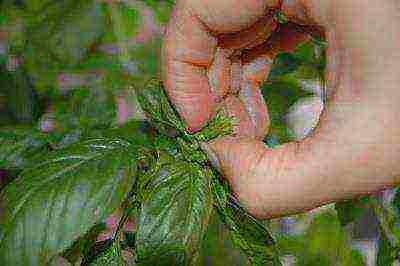
Pinching basil photo
Pinch the basil regularly by removing the flower brushes. This will improve the branching of the bush and increase the green mass, as well as the duration of the growing season of the plants.
Top dressing
For the accumulation of vitamins and aromatic substances, the plant needs fertilizing:
- Add the first one after 10-15 days of growth in the open field, the next one after another 3-4 weeks.
- Feed with nitrophos (2 tablespoons per 12 liters of water, add 3 liters of solution per 1 m²).
How to cut basil
The first crop can be harvested before flowering (around the end of July): carefully cut off the branches from the top of the plant, leaving some of the foliage at the base of the shoots. In August, flowering will begin, new more fragrant leaves will appear (during the flowering period, the concentration of essential oils is maximum). Start harvesting your second crop. Twigs can be cut at any time for serving. In early September, you can dig up a few basil bushes and plant them in pots. Thus, you will provide yourself with fresh greens for the winter.
Leaves can be eaten fresh, salted, dried. To dry, prepare wide baking sheets, cover them with a cotton cloth, spread the twigs in a thin layer. Dry in a dark place with good ventilation. The readiness is evidenced by the following: the stems should break easily, the leaves will be ground into powder. Store in glass or porcelain jars that are hermetically sealed.
Types and varieties of basil with photos and names
There are more than 150 plant species, consider the most popular.
Sweet basil or camphor Ocimum basilcum
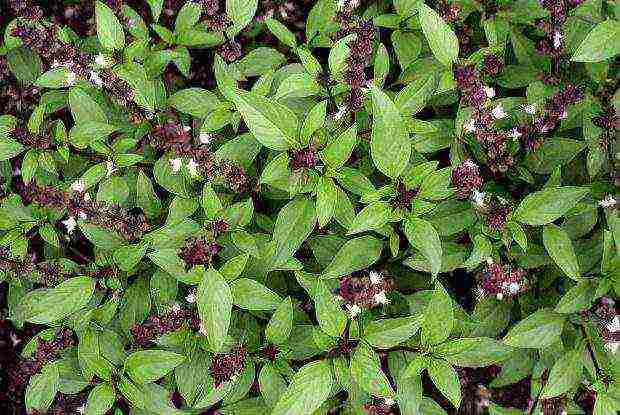
Sweet basil or camphor Ocimum basilcum photo
The most common type. The bush grows up to half a meter tall, the leaves are green, and have a tart taste.
Varieties:
Magical Michael - very abundant tillering.
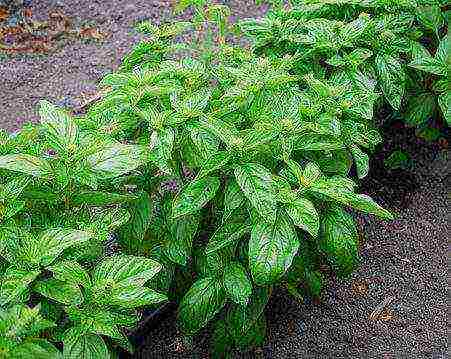
Fragrant basil cultivar Ocimum basilcum Mammoth photo
Mammoth - the leaf plates are larger, bitterness prevails in the taste.
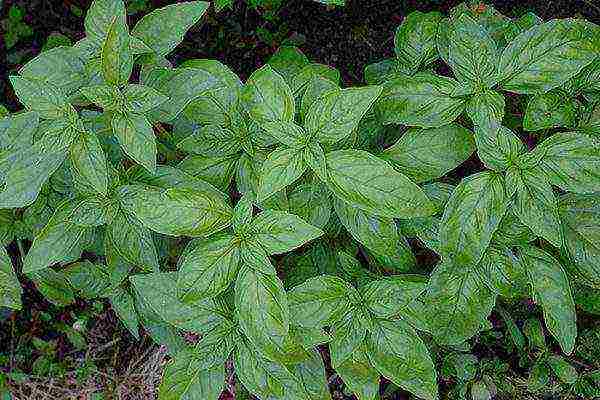
Sweet basil variety Ocinum basilicum ‘Genovese Gigante’ photo
Genovese Gigante - especially popular in Italy for its exquisite taste and aroma.
Basil cinnamon or Mexican Ocimum basilicum 'Cinnamon'
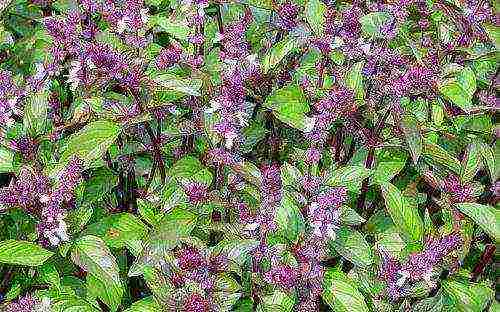
Basil cinnamon or Mexican Ocimum basilicum ‘Cinnamon’ photo
The leaves have a subtle cinnamon flavor.
Basil purple

Basil purple photo
The leaf plates are large, purple in color, and have a delicate taste.
Varieties:

Basil purple variety Purple Ruffles Basil photo
Osmin Purple - has dark purple leaves.
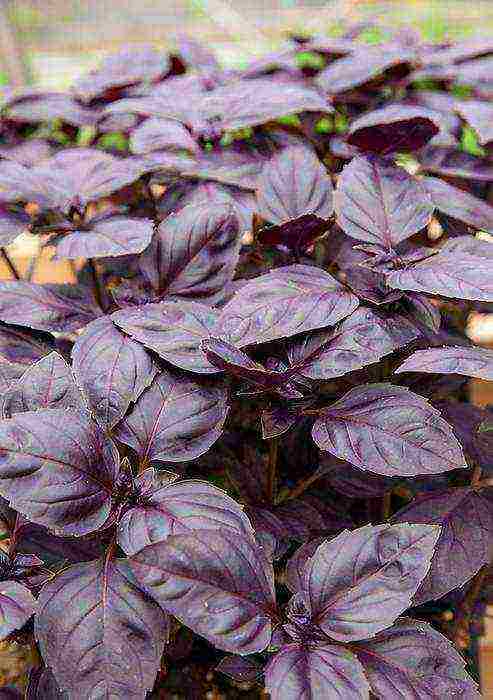
Basil purple variety Red Rubin photo
Red Rubin - purple-purple leaves.
Purpurascens - the taste of greens is tart and sweet.
Lemon basil
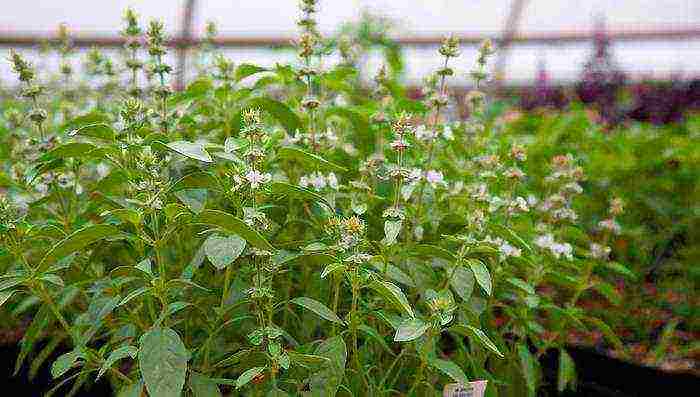
Lemon basil photo
The leaves are bright green in color, have a rich lemon aroma and the same aftertaste.
Varieties:
Basilico Genovese - rounded leaves.
Basilico Napoletano - Lemon aroma is most pronounced.
Growing basil through seedlings
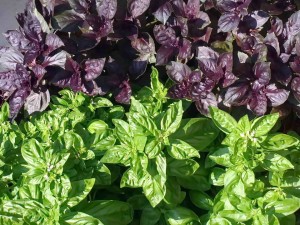 Basil is a favorite spice of many people. Anyone who does not have a summer residence is forced to buy it in supermarkets and bazaars, but whoever has even a small piece of land is a sin not to grow basil. Its maximum height reaches 70 cm, grows well in width.
Basil is a favorite spice of many people. Anyone who does not have a summer residence is forced to buy it in supermarkets and bazaars, but whoever has even a small piece of land is a sin not to grow basil. Its maximum height reaches 70 cm, grows well in width.
Best predecessors: potatoes, tomatoes and cucumbers.
Basil is usually grown through seedlings to get the harvest as early as possible, but in the southern regions, seeds can be sown directly into the nutrient soil to a depth of 1.5 cm.
Growing basil seedlings
To do this, at the end of March, you need to sow seeds in a nutritious and loose soil mixture of peat, humus and clean, washed sand in a ratio of 4: 2: 1. The soil mixture must first be sieved and steamed for 60 minutes for disinfection. If this item on soil preparation is omitted, then problems with seedlings are possible in the future. You can use purchased soil, in this case, treatment with a solution of potassium permanganate or the drug "Fitosporin" will be sufficient.
Use shallow containers (up to 7 cm) to grow basil seedlings. Fill the container with soil, slightly compacting, spread the seeds over the surface and cover them with earth so that they are at a depth of 1 cm.Carefully press the soil, pour, cover with transparent film or glass and put on a light and warm (20-25 ° С) a place. If you are sowing several varieties of basil at once, then do not forget to immediately place markers with the name of the variety.
When seedlings appear, about 10-14 days after sowing, remove the shelter and lower the temperature to 16-20 ° C, then the seedlings will not stretch. Basil does not like waterlogging, so pouring warm water, make sure that no water remains in the pan. Since this is a light-loving plant, if possible, organize additional supplementary lighting, especially in the first month, by increasing the daylight hours for seedlings to 6-8 hours.
The picking of basil seedlings is carried out when 2 true leaves appear, in separate cups (pots). The soil mixture is slightly improved by mixing with ash and complex mineral fertilizer (for 5 liters of soil mixture, 2 tablespoons of ash and fertilizer 1 tablespoon to the detriment). After filling the pots with an improved soil composition, compact, make a hole in the center, place the seedling at the same depth, cover with earth, slightly compact and water carefully. If the seedlings duck, correct them immediately. Water with lukewarm water only.
2 weeks before the intended planting of seedlings, begin to harden the plants, gradually reducing the air temperature, but not below + 10 ° C. Basil seedlings are ready for planting in open ground 40-50 days after germination, when the soil temperature becomes 15 ° C, approximately - the end of May. If weather conditions do not allow you to land on time, then pinch the shoots over a 6-8 leaf.
Planting basil outdoors
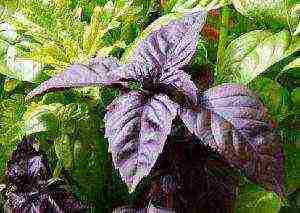 For growing basil, take a place protected from the wind, preferably loose and nutritious soil, light sandy loam soil rich in organic matter. Sand and peat are added to the clay soil.
For growing basil, take a place protected from the wind, preferably loose and nutritious soil, light sandy loam soil rich in organic matter. Sand and peat are added to the clay soil.
Young plants are planted in holes to a depth of 6-8 cm with an earthen lump at a distance of 25-30 cm, keeping the distance between rows 30-40 cm. If the seedlings were picked into peat-humus pots, then it is not necessary to extract the plants from them. When planting, make sure that the central kidney is not buried.
Water in a timely manner, avoiding drought. During the growing season, they are fed with ammonium nitrate 20 g per 1 sq. M. When re-feeding, add 15-20 g superphosphate per 1 sq. M.
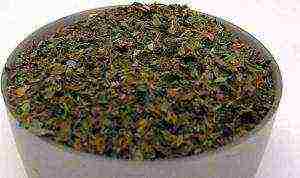 To build up more green mass, flower buds are removed, and the upper shoot is pinched.
To build up more green mass, flower buds are removed, and the upper shoot is pinched.
To combat basil diseases (fusarium, gray rot), do not use chemical preparations. The diseased plants are removed and the soil is dug onto the bayonet of the shovel after harvesting the entire crop.
Cut off shoots at a length of 10-12 cm, and for drying during the flowering period above 10 cm from the soil surface. Arrange in one layer and dry in dry, sunny weather under a canopy. A well-dried basil shoot breaks easily, and the leaves are crushed into dust.


